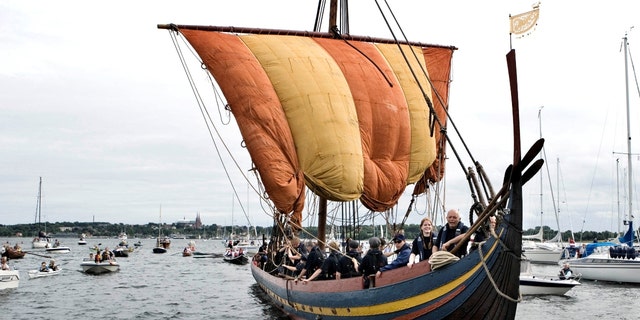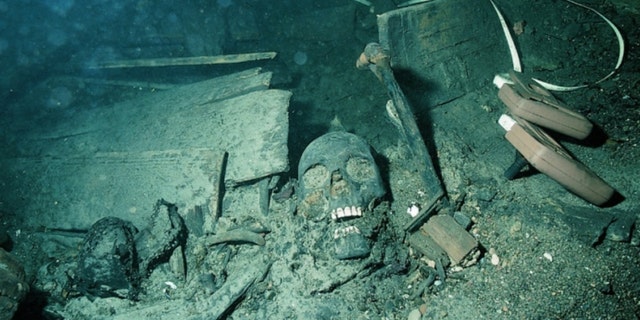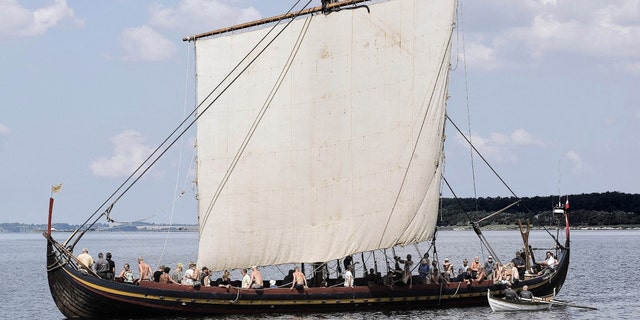Researchers say that the Viking Age left an imprint on the genetics of present-day Scandinavians.
In an international study published Thursday in the journal Cell, scientists found that DNA from archeological remains shows exceptional immigration to Scandinavia during that era.
The authors analyzed 297 ancient Scandinavian genomes dating back two millennia with the genomic data of 16,638 present-day Scandinavians.
“As the geographical origin and the datings were known for all these individuals, it was possible to resolve the development of the gene pool to a level never realized previously,” the University of Stockholm, where many authors were listed, said in a press release.
CALIFORNIA WHALE WATCHERS EXPERIENCE ‘ONCE-IN-A-LIFETIME SIGHTING’ OF GRAY WHALE, NEWBORN CALF

The Viking ship Havhingsten af Glendalough (the Sea Stallion of Glendalough), a replica of a Viking warship, sets out from the Viking Museum in Roskilde July 1, 2007.
(REUTERS/Scanpix/Bjarke Orsted/File Photo)
The university noted that the analysis found a surprising increase of variation during the Viking period that indicates gene flow into Scandinavia was especially intense during this period.
Women from the east Baltic region and, to a lesser extent, the British and Irish isles contributed more to the gene pool of Scandinavia than the men from those regions during that time.
“With this level of resolution, we not only confirm the Viking Age migration. We are also able to trace it to the east Baltic region, the British-Irish Isles and southern Europe,” Ricardo Rodríguez-Varela of the Centre for Palaeogenetics said in a statement.
“But not all parts of Scandinavia received the same amounts of gene flow from these areas. For example, while British-Irish ancestry became widespread in Scandinavia, the eastern Baltic ancestry mainly reached Gotland and central Sweden.”
He told Reuters there was no way to know the number of women involved or if the women with east Baltic and British-Irish ancestries were in Scandinavia voluntarily.
The study also found that British-Irish ancestry was widespread in Scandinavia starting during the Viking Age, which extended from about 750 to 1050 A.D.

Underwater excavations of the ship Kronan
(Lars Einarsson/Kalmar County Museum)
The authors said that eastern Baltic ancestry was found to be more localized to Gotland, Sweden’s largest island, and central Sweden.
OLDEST KNOWN DNA PAINTS STUNNING PICTURE OF LIFE 2 MILLION YEARS AGO
“The increase of eastern Baltic ancestry in these regions during the Viking Age is consistent with historical sources attesting to contacts such as tributary relations and treaties,” Rodriguez-Varela, one of the study’s leaders, said. “Therefore, we don’t see any evidence with the present data to support that women were abducted and brought back during raids.”
While ancestry from southern European locations like Sardinia was concentrated in people in southern Scandinavia, the group determined that modern Scandinavians have less non-local ancestry than Viking Age samples.
The university said it was surprised to find that the gene pool had bounced back in the direction of what it looked like before the Viking migration.

The replica of a Viking ship, the 30-meter (100-foot) Havhingsten (Seastallion), sails into the fjord of Roskilde, after a trip to Oslo and Tonsberg in Norway Aug. 4, 2006.
(REUTERS/Jens Norgaard Larsen/Scanpix/File Photo)
A new discovery was the history of the northern Scandinavian gene pool with the study finding that a genetic component there is rare in central and western Europe.
“We suspected that there was a chronology to the northern Scandinavian gene pool, and it did indeed prove that a more recent influx of Uralic ancestry into Scandinavia define much of the northern gene pool,” Rodríguez-Varela said in the university’s release. “But if it is recent, it is comparatively so. For example, we know that this Uralic ancestry was present in northern Scandinavia as early as during the late Viking period.”
CLICK HERE TO GET THE FOX NEWS APP
The study was based on a number of well-known Swedish archeological sites, including genomes from the 17th-century warship Kronan, which was sunk in a 1676 battle.
Others came from Sanby borg on Öland, the second-largest Swedish island.
“We were working on a number of smaller studies on different archeological sites. And, at some point, it just made sense to combine them into a larger study on the development of the Scandinavian gene pool,” professor Anders Götherström, a senior scientist on the study, said.
Reuters contributed to this report.
